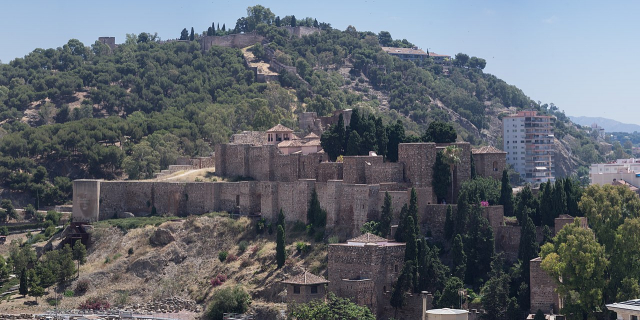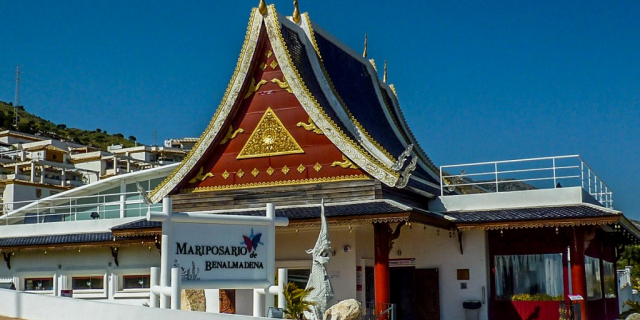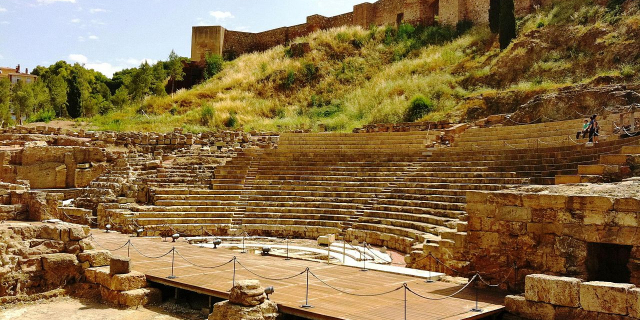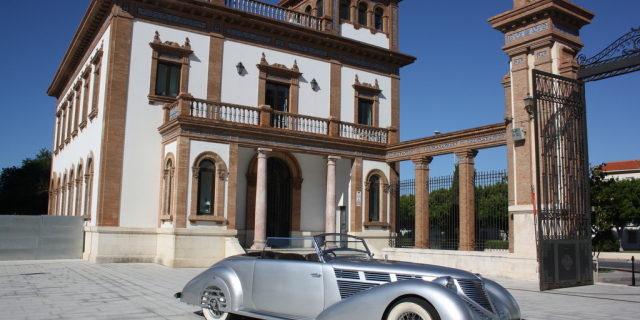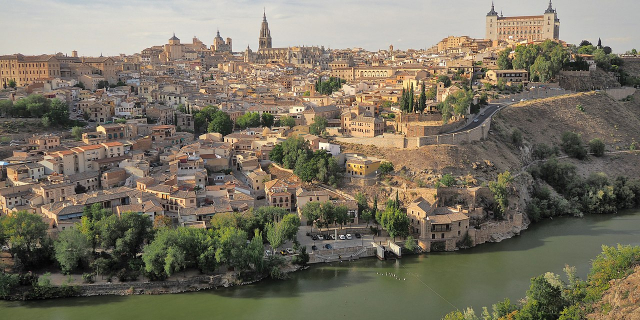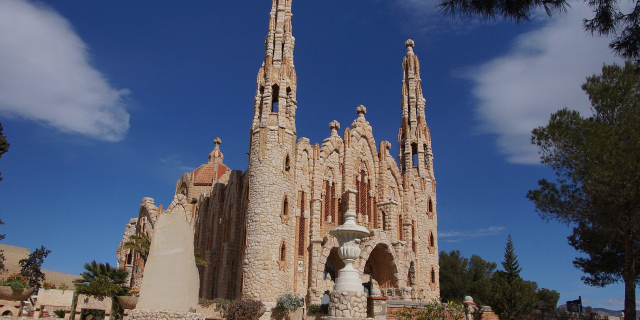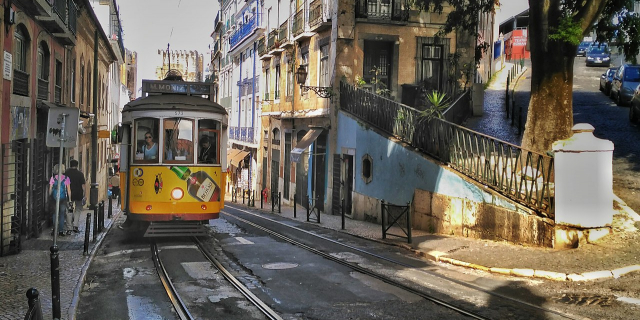Málaga
Context of Málaga
Málaga ( (listen) MAL-ə-gə, Spanish: [ˈmalaɣa]) is a municipality of Spain, capital of the Province of Málaga, in the autonomous community of Andalusia. With a population of 578,460 in 2020, it is the second-most populous city in Andalusia and the sixth most populous in the country. It lies in Southern Iberia on the Costa del Sol ("Coast of the Sun") of the Mediterranean, primarily in the left bank of the Guadalhorce. The urban core originally developed in the space in between the Gibralfaro Hill and the Guadalmedina.
Málaga's history spans about 2,800 years, making it one of the oldest continuously inhabited cities i...Read more
Málaga ( (listen) MAL-ə-gə, Spanish: [ˈmalaɣa]) is a municipality of Spain, capital of the Province of Málaga, in the autonomous community of Andalusia. With a population of 578,460 in 2020, it is the second-most populous city in Andalusia and the sixth most populous in the country. It lies in Southern Iberia on the Costa del Sol ("Coast of the Sun") of the Mediterranean, primarily in the left bank of the Guadalhorce. The urban core originally developed in the space in between the Gibralfaro Hill and the Guadalmedina.
Málaga's history spans about 2,800 years, making it one of the oldest continuously inhabited cities in Western Europe. According to most scholars, it was founded about 770 BC by the Phoenicians from Tyre as Malaka. From the 6th century BC the city was under the hegemony of Ancient Carthage, and from 218 BC, it was under Roman rule, economically prospering owing to garum production. In the 8th century, after a period of Visigothic and Byzantine rule, it was placed under Islamic rule. In 1487, the Crown of Castile gained control in the midst of the Granada War. In the 19th century, the city underwent a period of industrialisation followed by a decay in all socioeconomic parametres in the last third of the century.
The most important business sectors in Málaga are tourism, construction and technology services, but other sectors such as transportation and logistics are beginning to expand. Málaga has consolidated as tech hub, with companies mainly concentrated in the Málaga TechPark (Technology Park of Andalusia). It hosts the headquarters of the region's largest bank, Unicaja, and it is the fourth-ranking city in Spain in terms of economic activity behind Madrid, Barcelona and Valencia. Regarding transportation, Málaga is served by the Málaga–Costa del Sol Airport and the Port of Málaga, whereas the city is connected to the high-speed railway network since 2007.
More about Málaga
- Population 586384
- Area 394
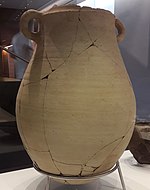 Clay amphora from the Cerro del Villar site, near the mouth of the Guadalhorce (6th century BC).
Clay amphora from the Cerro del Villar site, near the mouth of the Guadalhorce (6th century BC).Phoenicians from Tyre founded a colony named Málaka (Greek: Μάλακα)[1] or Malake[2] about 770 BC (Punic: 𐤌𐤋𐤊𐤀, MLKʾ).[2] The town controlled access to the Guadalmedina and served as a waypoint on trade routes between Phoenicia and the Strait of Gibraltar. Like other Phoenician colonies, it fell under Carthaginian rule during the 6th or 5th century BC. The Phoenician and Later Roman urban core developed around an area running from the Gibralfaro Hill to the mouth of the Malaca flumen (Guadalmedina).[3]
After the Punic Wars, the Roman Republic took control of the town known to them as Malaca. By the 1st century BC, Strabo alluded to its Phoenician profile, in contrast to the hellenized characteristics of the neighbouring settlement of Mainake.[4]
...Read moreRead less Clay amphora from the Cerro del Villar site, near the mouth of the Guadalhorce (6th century BC).
Clay amphora from the Cerro del Villar site, near the mouth of the Guadalhorce (6th century BC).Phoenicians from Tyre founded a colony named Málaka (Greek: Μάλακα)[1] or Malake[2] about 770 BC (Punic: 𐤌𐤋𐤊𐤀, MLKʾ).[2] The town controlled access to the Guadalmedina and served as a waypoint on trade routes between Phoenicia and the Strait of Gibraltar. Like other Phoenician colonies, it fell under Carthaginian rule during the 6th or 5th century BC. The Phoenician and Later Roman urban core developed around an area running from the Gibralfaro Hill to the mouth of the Malaca flumen (Guadalmedina).[3]
After the Punic Wars, the Roman Republic took control of the town known to them as Malaca. By the 1st century BC, Strabo alluded to its Phoenician profile, in contrast to the hellenized characteristics of the neighbouring settlement of Mainake.[4]
Transformed into a confederated city, it was under a special law, the Lex Flavia Malacitana. A Roman theatre was built at this time.[5] After the fall of the Western Roman Empire, it was ruled first by the Visigoths. The city was taken circa 552 by the Byzantine Empire;[6] either Malaca or Carthago Nova possibly then becoming the capital of the province of Spania.[7] The Byzantines restored and expanded the docks, thus consolidating the fishing and trading tradition the city already enjoyed.[7] The city was retaken by the Visigoth King Sisebuto in 615.[8] The Islamic conquest of Málaga (rendered as مالقة—Mālaqah—in Arab sources) by Arab and Berber forces took place in 711 or perhaps 713.[9] Following a period of diminished importance during the early stages of the emiral period already in force since before the conquest, Málaga was fully Islamized by the end of the aforementioned period in the wake of Muhammad I's attributed intervention in the urban configuration as a medina.[10]
 A 19th-century reconstruction of Islamic Malaqah
A 19th-century reconstruction of Islamic MalaqahThe consolidation of the city's importance after 930 (under the Caliphate of Córdoba) ran parallel to the diminishing fortune of Archidona, the latter of which Málaga replaced as the capital of the corresponding kura of Rayya.[11][12] The early 10th-century chronicle of Aḥmad al-Rāzī mentions the vineyards of Málaga, extolling the unparalleled quality of its raisins.[13] In the 11th century, following the unravelling of Umayyad authority across the caliphate, Málaga became a centre of power of the Hammudids, who established a petty kingdom (nominally also a caliphate) in the city, the taifa of Málaga, complemented by the also Hammudid sister dominion in Ceuta across the Strait of Gibraltar.[14] The city was seized away from the Hammudids by the Granadan Zirids in 1056 or 1057, and also underwent an ephemeral spell under the Sevillian Abbadids by 1066 before returning back to the former.[15] By the late 11th century, the Zirids lost the city to the North-African Almoravids.[15]
The traveller Ibn Battuta, who passed through around 1325, characterised it as "one of the largest and most beautiful towns of Andalusia [uniting] the conveniences of both sea and land, and... abundantly supplied with foodstuffs and fruits". He praised its grapes, figs, and almonds; "its ruby-coloured Murcian pomegranates have no equal in the world." Another exported product was its "excellent gilded pottery". The town's mosque was large and beautiful, with "exceptionally tall orange trees" in its courtyard.[16]
Ceramic plate from Málaga (14th century)After the formation of the Nasrid Kingdom of Granada in the 13th century, Málaga became a part of it.[17] The export-oriented harbour traded silk fabrics, dry nuts (raisins, almonds and the famous Raiya figs, reportedly exported to as far as China), vine, cutlery, leather and the famous regional lustreware.[17]
In the 15th century, Málaga was the main Nasrid port (followed by Almería),[18] featuring a notable presence of Genoese merchants.[19] It played a role both as stopover of the Atlantic international trade (as part of the routes connecting the Central Mediterranean to the North Atlantic) and as regional trading cog of the Kingdom of Granada.[20] By the last rales of Nasrid rule, the city had a population of about 15,000.[21]
Málaga was seized by Christian forces on 18 August 1487,[22] after a 3-month 11 days siege,[23] in what was the most violent episode of the Granada War. The Muslim inhabitants resisted assaults and artillery bombardments before hunger forced them to surrender; practically the entire remaining population (around 11,000 people) became war captives and were sold into slavery in other Andalusian cities as well as Valencia and Barcelona.[24][25] Only a minority of around 50 people led by merchant Alí Dordux were allowed to remain in the city.[26]
The city's Muslim population was converted to Catholic Christianity and the city was swiftly repopulated by Christian settlers coming from different locations of the Iberian Peninsula.[26] Málaga became an exporting centre for Andalusia via the link of the city with Antequera and Córdoba, maintaining its trading character despite the nearly complete replacement of the population.[27] The city did not escape a series of typhus fever outbreaks following its annexation to the Crown of Castile.[28]
Following the death of regent Ferdinand the city rose in revolt in 1516 on the occasion of the installment of a new court controlled by the Admiral of Castile.[29] It was only on 2 December 1530 when Málaga was freed from the influence of the Admiralty for good, confirming the privileges granted in the past by the Catholic Monarchs.[30]
 Málaga in 1572: Castle of Gibralfaro (center)
Málaga in 1572: Castle of Gibralfaro (center)As of 1625, Málaga may have had a population of around 36,000.[31]
On 24 August 1704 the indecisive Battle of Málaga, the largest naval battle in the War of the Spanish Succession, took place in the sea south of Málaga.[32]
The city's economy profited from an early industrialisation in the first third of the 19th century and the population steadily increased until the last years of the century,[33] when the population decreased between 1887 and 1897 due to the economic crisis induced by the Phylloxera grapevine pest.[34] The century saw the accumulation of capital in an enriched bourgeoisie class, that invested in the incipient industrial development.[35]
The municipality of Málaga annexed the coastal town of Torremolinos in 1924.
 Republican refugees fleeing Málaga during the Desbandá (8 February 1937).
Republican refugees fleeing Málaga during the Desbandá (8 February 1937).After the coup of July 1936 the government of the Second Republic retained control of Málaga. Its harbour was a base of the Republican navy at the beginning of the Spanish Civil War. It suffered heavy bombing by Italian warships which took part in breaking the Republican navy's blockade of Nationalist-held Spanish Morocco and took part in naval bombardment of Republican-held Málaga.[36] After the Battle of Málaga and the Francoist takeover in February 1937, over seven thousand people were killed,[37] as they were trying to flee the city through the road to Almería.[a]
Torremolinos—originally a small coastal town—greatly developed in the late 1950s and early 1960s, becoming an international tourist centre.[38] The first gay bar in Spain was opened in Torremolinos in 1962 (and the first lesbian club in 1968),[39] and the place acquired a lively LGBT life, to the point of being described as "the most 'cosmopolitan' and gay-friendly place in all of Spain".[40] Nearly a decade after, in 1971, a policial crackdown seeking to curb "offences against public morality and decency" largely put an end to the appeal of the place, only regaining its status as hub of LGBT leisure and tourism after the death of the dictator.[39]
Torremolinos became independent from the municipality of Málaga in September 1988.[41]
^ Strabo 3.4.2 ^ a b Huss (1985), p. 25 ^ Corrales Aguilar 2003, p. 377. ^ Corrales Aguilar 2003, p. 381. ^ Leucona, Emilio. «Jornadas de estudio por el 150 aniversario del hallazgo de la Lex Flavia Malacitana». Consulted on 7 April 2008. ^ Collado Campaña 2012, p. 2. ^ a b Collado Campaña 2012, p. 3. ^ Collado Campaña 2012, p. 5. ^ Ruiz Povedano, José María (2017). "Aproximaxión a la historia de Málaga musulmana" (PDF). Málaga, de musulmana a cristiana : la transformación de la ciudad a finales de la Edad Media. Granada: Editorial Universidad de Granada. p. 42. ISBN 9788433861481. ^ Ruiz Povedano 2017, pp. 43–44. ^ Íñiguez Sánchez, María del Carmen; Cumpián Rodríguez, Alberto; Sánchez Bandera, Pedro Jesús (2003). "La Málaga de los siglos X-XI origen y consolidación del urbanismo islámico" (PDF). Mainake (25). ISSN 0212-078X. ^ Calero Secall, María Isabel (1993–1994). "Dos ciudades ḥammūdíes: Málaga y Ceuta". Miscelánea de Estudios Árabes y Hebraicos. Sección Árabe-Islam. Granada: Editorial Universidad de Granada. 42–43: 32–34. ISSN 1696-5868. ^ Torres Balbás, Leopoldo (1974). "Málaga como escenario histórico" (PDF). Arquitectura (187): 324. ISSN 0004-2706. ^ Calero Secall 1993–1994, p. 48. ^ a b Ruiz Povedano 2017, pp. 46–47. ^ "Ibn Battuta: Travels in Asia and Africa". Fordham.edu. 21 February 2001. Retrieved 8 April 2011. ^ a b Torres Balbás 1974, p. 329. ^ Fábregas García 2003–2004, pp. 79, 89. ^ Fábregas García 2003–2004, p. 79. ^ Fábregas García, Adela (2003–2004). "Redes de comercio y articulación portuaria del Reino de Granada: puertos y escalas en el tráfico marítimo bajomedieval" (PDF). Chronica Nova. 30: 85. ^ García Ruiz 2018, p. 83. ^ García Ruiz, María Victoria (2018). "Málaga en el tránsito de medina nazarí a urbe cristiana" (PDF). Péndulo: Revista de Ingeniería y Humanidades (29): 77. ISSN 1132-1245. ^ Góméz, Pedro Luis (19 August 2016). "Tal día como hoy hace 529 años". Diario Sur. ^ González Arévalo, Raúl (2019). "La esclavitud en la España Medieval. (siglos XIV-XV). Generalidades y rasgos diferenciales". Millars: Espai i historia. 47 (2): 18–19. ISSN 1132-9823. ^ Blood and Faith: The Purging of Muslim Spain, Matthew Carr, page 7, 2009 ^ a b García Ruiz 2018, p. 77. ^ Ladero Quesada, Miguel Ángel (1992). "Mudéjares y repobladores en el Reino de Granada (1485-1501)". Cuadernos de Historia Moderna. 13: 62. ^ López Beltrán, María Teresa (2003). "Los portugueses en el poblamiento inicial de Málaga (1487–1497)" (PDF). Os reinos ibéricos na Idade Média: livro de homenagem ao professor doutor Humberto Carlos Baquero Moreno. Vol. 1. p. 1148. ISBN 972-26-2134-3. ^ Reder Gadow 2017, pp. 323–334. ^ Reder Gadow, Marion (2017). "Málaga en tiempos del Emperador Carlos V". In Toro Ceballos, Francisco (ed.). Carolus. pp. 323–334. ISBN 978-84-89014-76-3. ^ Pérez de Colosía Rodríguez, Mª Isabel; Gil Sanjuán, Joaquín (1981). "Málaga en tiempos de Felipe IV" (PDF). Baetica, Histórico. Málaga: UMA Editorial (4): 213. doi:10.24310/BAETICA.1981.v0i4.962. hdl:10630/8973. S2CID 258077549. ^ "La batalla naval de Málaga, en 1704: 20.000 hombres y 3.000 piezas de artillería". La Opinión de Málaga (in Spanish). 23 February 2014. Retrieved 13 January 2021. ^ Ibáñez Linares 2018, p. 232. ^ Ibáñez Linares 2018, p. 233. ^ Ordóñez Vergara 1993, p. 163. ^ Balfour, Sebastian; Preston, Paul (2009). Spain and the great powers in the twentieth century. London, UK; New York, US: Routledge. p. 172. ISBN 978-0-415-18078-8. ^ Antony Beevor, The Battle for Spain: The Spanish Civil War 1936–1939. London: Weidenfeld & Nicolson. 2006, ISBN 0-297-84832-1 ^ Fernández Galeano, Javier (2016). "Is He a "Social Danger"?: The Franco Regime's Judicial Prosecution of Homosexuality in Málaga under the Ley de Vagos y Maleantes". Journal of the History of Sexuality. 25 (1): 8. ^ a b Gómez, Alberto (29 April 2019). "La noche en que la dictadura acabó con el ambiente gay de Torremolinos". Sur. ^ Fernández Galeano 2016, p. 10. ^ Gómez, Alberto (27 September 2015). "Torremolinos celebra 27 años del "¡Ya somos catetos!"". Sur.
Cite error: There are <ref group=lower-alpha> tags or {{efn}} templates on this page, but the references will not show without a {{reflist|group=lower-alpha}} template or {{notelist}} template (see the help page).






